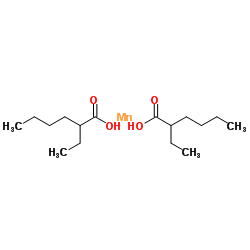13434-24-7
| Name | Manganese bis(2-ethylhexanoate) |
|---|---|
| Synonyms |
MFCD00058698
2-Ethylhexanoic acid - manganese (2:1) Hexanoic acid, 2-ethyl-, manganese salt (2:1) EINECS 236-562-0 |
| Density | 0.940 ---0.955 g/cm3 |
|---|---|
| Boiling Point | 228ºC at 760 mmHg |
| Molecular Formula | C16H30MnO4 |
| Molecular Weight | 343.361 |
| Flash Point | 116.6ºC |
| Exact Mass | 343.168121 |
| PSA | 52.60000 |
| LogP | 4.42060 |
| Water Solubility | Soluble in organic solvents. Not miscible or difficult to mix with water. |
|
Section 1: Product Identification Chemical Name:Manganese (II) 2-ethylhexanoate, 40% solution in mineral spirits (6% Mn) CAS Registry Number:13434-24-7 Formula:Mn[OOCCH(C2H5)C4H9]2 EINECS Number:none Chemical Family:metal carboxylate Synonym:2-Ethylhexanoic acid, manganese +2 salt
Section 2: Composition and Information on Ingredients IngredientCAS NumberPercentACGIH (TWA)OSHA (PEL) Title compound13434-24-740%0.2mg/m3 (as Mn)5mg/m3 (as Mn) mineral spirits64475-85-060%no datano data Section 3: Hazards Identification Emergency Overview:Irritating to skin, eyes and respiratory tract. May be harmful if swallowed or inhaled. Primary Routes of Exposure:Ingestion, inhalation Eye Contact:Causes mild irritation of the eyes. Skin Contact:Causes slight to mild irritation of the skin. Inhalation:Vapor is irritating to the nose, mucous membranes and respiratory tract, and cause drowsiness. Ingestion:No information available on the physiological effects of ingestion. Acute Health Affects:Irritating to skin, eyes and respiratory tract. Prolonged exposure to manganese containing dust may produce manganese pneumonitis and manganese Chronic Health Affects:poisoning. Symptoms include sleepiness, weakness and emotional disturbances. Equivocal studies have shown manganese may decrease fertility in men. NTP:No IARC:No OSHA:No SECTION 4: First Aid Measures Immediately flush the eyes with copious amounts of water for at least 10-15 minutes. A victim may need Eye Exposure: assistance in keeping their eye lids open. Get immediate medical attention. Wash the affected area with water. Remove contaminated clothes if necessary. Seek medical assistance if Skin Exposure: irritation persists. Remove the victim to fresh air. Closely monitor the victim for signs of respiratory problems, such as difficulty Inhalation: in breathing, coughing, wheezing, or pain. In such cases seek immediate medical assistance. Seek medical attention immediately. Keep the victim calm. Give the victim water (only if conscious). Induce Ingestion: vomiting only if directed by medical personnel. SECTION 5: Fire Fighting Measures Flash Point:no data Autoignition Temperature:no data Explosion Limits:no data Extinguishing Medium:carbon dioxide, foam or dry powder If this product is involved in a fire, fire fighters should be equipped with a NIOSH approved positive pressure Special Fire Fighting Procedures: self-contained breathing apparatus and full protective clothing. Hazardous Combustion andIf involved in a fire this material may emit irritating fumes. Decomposion Products: Unusual Fire or Explosion Hazards: Flammable. No unusual fire or explosion hazards. SECTION 6: Accidental Release Measures Small spills can be mixed with vermiculite or other suitable chemical adsorbent. The residue can be swept up Spill and Leak Procedures: and properly disposed of. SECTION 7: Handling and Storage Handling and Storage:Store in a tightly sealed container. Handle the material in a ventilated area. SECTION 8: Exposure Controls and Personal Protection Eye Protection:Always wear approved safety glasses when handling a chemical substance in the laboratory. Skin Protection:Wear protective clothing and gloves. Ventilation:If possible, handle the material in an efficient fume hood. If ventilation is not available a respirator should be worn. The use of respirators requires a Respirator Respirator: Protection Program to be in compliance with 29 CFR 1910.134. Ventilation:If possible, handle the material in an efficient fume hood. Additional Protection:No additional protection required. SECTION 9: Physical and Chemical Properties Color and Form:dark liquid Molecular Weight:341.35 Melting Point:no data Boiling Point:no data Vapor Pressure:no data Specific Gravity:no data Odor:mild organic odor Solubility in Water:insoluble SECTION 10: Stability and Reactivity Stability:air and moisture stable liquid Hazardous Polymerization:none Conditions to Avoid:exposure to excessive heat or an ignition source. Incompatibility:strong oxidizing agents Decomposition Products:carbon dioxide, carbon monoxide, organic fumes, and manganese oxides. SECTION 11: Toxicological Information No information available on the title compound. For mineral spirits: Oral (rat); LD50: >34600mg/kg. RTECS Data: Inhalation (rat); LC50: >21400mg/m3/hr. Intraperitoneal (rat); LDLo: 8560 mg/kg. Carcinogenic Effects:No data available Mutagenic Effects:No data available Tetratogenic Effects:No data available SECTION 12: Ecological Information Ecological Information:No information available SECTION 13: Disposal Considerations Disposal:Dispose of according to local, state and federal regulations. SECTION 14: Transportation Shipping Name (CFR):Flammable liquids, N.O.S. Hazard Class (CFR):3 Additional Hazard Class (CFR):NA Packaging Group (CFR):III UN ID Number (CFR):UN# 1993 Shipping Name (IATA):Flammable liquid, N.O.S. Hazard Class (IATA):3 Additional Hazard Class (IATA):NA Packaging Group (IATA):III UN ID Number (IATA):UN# 1993 SECTION 15: Regulatory Information TSCA:listed on the TSCA inventory SARA (Title 313):Title compound: See category code N450 for reporting Second Ingredient:not listed on the TSCA inventory SECTION 16 - ADDITIONAL INFORMATION N/A |
| Hazard Codes | Xn: Harmful; |
|---|---|
| Risk Phrases | R10 |
| Safety Phrases | 16-36/37/39 |
| RIDADR | UN 1993 |
| Packaging Group | III |

